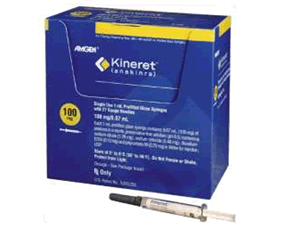
Inflammatory cytokines, in particular IL-1, are elevated in the synovial fluid of patients with knee osteoarthritis (OA); however, their contribution to OA symptoms and damage are unclear. A small study (n=13) in which the IL-1 inhibitor anakinra was injected into the knee of OA patients suggested a possible benefit on pain and function. Here, Chevalier et al (Arthritis Rheum 2009; 61(3): 344) report the short-term efficacy of intra-articular anakinra on knee OA symptoms in a double-blind, randomized, placebo-controlled clinical trial.
Methods
Adults with painful radiographic tibiofemoral knee OA that was not end-stage were randomized to receive anakinra (150 mg or 50mg) or placebo, randomized in a 2:1:2 fashion. Patients received a blind injection of study drug into the index knee. The primary study outcome was change in knee symptoms, measured using the pain, stiffness, and physical function subscales of the WOMAC, 4 weeks after injection. Other outcomes included pain VAS, the amount of rescue analgesia used, serum and urine biomarkers of collagen synthesis and degradation at weeks 4 and 12 after injection, and safety. A subset of subjects had serum pharmacokinetic analysis.
Results
A total of 170 subjects were enrolled (n=69 to placebo, n=34 to anakinra 50mg, n=67 to anakinra 150 mg) with 160 (94%) completing the study. No withdrawals were secondary to adverse events. Study subjects were predominantly female (63%), Caucasian (88%), with a mean age of 63 years and a mean duration of OA of 6 years. The majority of patients (58%) had advanced radiographic knee OA (Kellgren/Lawrence grade 3) with a wide variability in WOMAC scores reported.
All groups had decreases in total and subscale WOMAC scores at all time points of the study; however, there were no statistically significant differences between the three study groups at any time point. There was a trend to significance between the placebo group and the anakinra 150 mg group in pain at day 4 associated with an approximately 50 unit difference in the decrease in WOMAC pain score favoring the anakinra 150 mg group (p=0.051). There were no significant differences in quality of life measures or use of analgesics between the three groups. Serum anakinra concentrations leveled off at two days post-injection and decreased thereafter, with a terminal half-life of 4 hours. Injection site reactions were observed as frequently in the placebo group as in the anakinra groups. Adverse and serious adverse events were balanced between the groups, although non-serious infections were more frequent in the anakinra 150 mg group compared to the placebo or anakinra 50 mg groups (18% vs. 6% and 3%, respectively.
Conclusions
A single intra-articular injection of anakinra was not more efficacious than placebo in decreasing the signs and symptoms of painful knee OA.
Editorial Comment
The search for effective disease modifying agents for OA has remained elusive. The apparent importance of IL-1 in the pathophysiologic mechanism of cartilage damage in OA, coupled with suggestive animal studies with IL-1 inhibition, held promise that IL-1 inhibition may be an effective treatment strategy for human OA. What are some of the reasons for the lack of efficacy observed in this study other than a true lack of effect? One possibility is that a single intra-articular injection is not enough exposure to IL-1 inhibition to expect results, particularly as the drug does not appear to concentrate within the joint. Another is that IL-1 inhibition may be required much earlier in the disease process, before significant cartilage damage has occurred, as it is unlikely that IL-1 inhibition will promote repair. Recent investigations have linked pain in knee OA not to cartilage, but to subclinical synovitis and bone marrow edema. It is possible that the early difference in pain responses favoring the high dose anakinra group observed in this study could have been related to effects of IL-1 inhibition on synovitis. However, similar effects would likely have been observed with intraarticular glucocorticoids, which have a longer track record of use and are much less expensive. Whether repeated intraarticular injections of anakinra are efficacious requires further investigation; however, the logistics of repeated administration may not be feasible.

